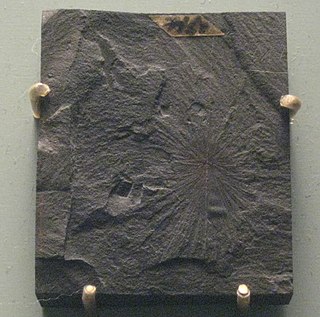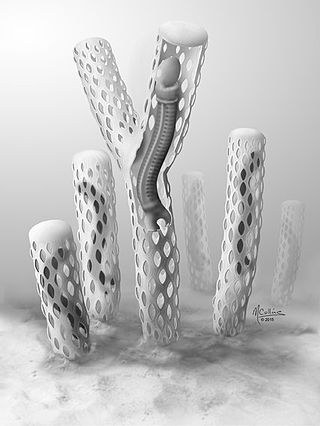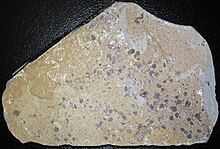
Choia is a genus of extinct demosponge ranging from the Cambrian until the Lower Ordovician periods. Fossils of Choia have been found in the Burgess Shale in British Columbia; the Maotianshan shales of China; the Wheeler Shale in Utah; and the Lower Ordovician Fezouata formation. It was first described in 1920 by Charles Doolittle Walcott.

Odaraia is a genus of bivalved arthropod from the Middle Cambrian. Its fossils, which reach 15 centimetres (5.9 in) in length, have been found in the Burgess Shale in British Columbia, Canada.

Marpolia has been interpreted as a cyanobacterium, but also resembles the modern cladophoran green algae. It is known from the Middle Cambrian Burgess shale and Early Cambrian deposits from the Czech Republic. It comprises a dense mass of entangled, twisted filaments. It may have been free-floating or grown on other objects, although there is no evidence of attachment structures. 40 specimens of Marpolia are known from the Greater Phyllopod bed, where they comprise 0.08% of the community.
Yuknessia is an early pterobranch, known from the Burgess shale, the Chengjiang and the Wheeler shale. Long, unbranched fronds emerge from a central holdfast-like body covered in small conical plates. 23 specimens of Yuknessia are known from the Greater Phyllopod bed, where they comprise < 0.1% of the community. The genus contains two species: the type species Y. simplex and Y. stephenensis. It was originally interpreted as a green alga, and has since been reinterpreted it as a colonial pterobranch.
Dalyia is a pterobranch known from the middle Cambrian Burgess shale. It was previously interpreted as a red alga. It has smooth or faintly lineated stems, which branch into up to four equal branches at branching points. 37 specimens of Dalyia are known from the Greater Phyllopod bed, where they comprise 0.07% of the community.

Plenocaris plena is a genus of extinct bivalved hymenocarine arthropod that lived in the Cambrian aged Burgess Shale and Chengjiang. Originally described as a species of Yohoia by Walcott in 1912, it was placed into its own genus in 1974.

Liangshanella is a genus of Cambrian bradoriid known from the Chengjiang biota and Burgess Shale. 6263 specimens of Liangshanella are known from the Greater Phyllopod bed, where they comprise 11.9% of the community.
Girvanella is a fossil thought to represent the calcified sheath of a filamentous cyanobacterium known from the Burgess Shale and other Cambrian fossil deposits. Specimens are also known from the Early Ordovician San Juan Formation, Argentina.
The Phyllopod bed, designated by USNM locality number 35k, is the most famous fossil-bearing member of the Burgess Shale fossil Lagerstätte. It was quarried by Charles Walcott from 1911–1917, and was the source of 95% of the fossils he collected during this time; tens of thousands of soft-bodied fossils representing over 150 genera have been recovered from the Phyllopod bed alone.
Bosworthia is a genus of branching photosynthetic alga known from the Middle Cambrian Burgess Shale. 20 specimens of Bosworthia are known from the Greater Phyllopod bed, where they comprise 0.04% of the community. One of its two original species has since been reassigned to Walcottophycus.

Falospongia is a genus of sponge made up of radiating fronds, known from the Middle Cambrian Burgess Shale. Its name is derived from the Latin fala ("scaffold") and spongia ("sponge"), referring to the open framework of the skeleton. It superficially resembles Haplistion but is monaxial. 5 specimens of Falospongia are known from the Greater Phyllopod bed, where they comprise under 0.1% of the community.
Mackenzia is an elongated bag-like animal known from the Middle Cambrian Burgess Shale. It attached directly to hard surfaces, such as brachiopod shells. 14 specimens of Mackenzia are known from the Greater Phyllopod bed, where they comprise <0.1% of the community. Mackenzia was originally described by Charles Walcott in 1911 as a holothurian echinoderm. Later, Mackenzia is thought to be a cnidarian and appears most similar to modern sea anemones.

Micromitra is a genus of brachiopods known from the Middle Cambrian Burgess Shale. 160 specimens of Micromitra are known from the Greater Phyllopod bed, where they comprise 0.3% of the community.
Leptomitus is a genus of demosponge known from the Middle Cambrian Burgess Shale. Its name is derived from the Greek lept ("slender") and mitos ("thread"), referring to the overall shape of the sponge. 138 specimens of Leptomitus are known from the Greater Phyllopod bed, where they comprise 0.26% of the community.

Oesia disjuncta is a monospecific genus of hemichordate known from the Middle Cambrian Burgess Shale. 1147 specimens of Oesia are known from the Greater Phyllopod bed, where they comprise 2.18% of the community. It was previously compared to the chaetognaths, annelids and tunicates.
Peronochaeta is a genus of annelid known from the Middle Cambrian Burgess Shale. 19 specimens of Peronochaeta are known from the Greater Phyllopod bed, where they comprise < 0.1% of the community. The genus was described by Conway Morris (1979) and re-examined by Eibye-Jacobsen (2004).

Pirania is an extinct genus of sea sponge known from the Middle Cambrian Burgess Shale and the Ordovician Fezouata formation. It is named after Mount St. Piran, a mountain situated in the Bow River Valley in Banff National Park, Alberta. It was first described in 1920 by Charles Doolittle Walcott. 198 specimens of Pirania are known from the Greater Phyllopod bed, where they comprise 0.38% of the community.
Protospongia is a genus of Porifera known from the Middle Cambrian Burgess Shale. 102 specimens of Protospongia are known from the Greater Phyllopod bed, where they comprise 0.19% of the community.
Wapkia is an extinct genus of sea sponge with radial sclerites, known from the Middle Cambrian Burgess Shale. It was first described in 1920 by Charles Doolittle Walcott. 32 specimens of Wapkia are known from the Greater Phyllopod bed, where they comprise 0.06% of the community.

Diagoniella is a genus of sponge known from the Middle Cambrian Burgess Shale. 128 specimens of Diagoniella are known from the Greater Phyllopod bed, where they comprise 0.24% of the community.










